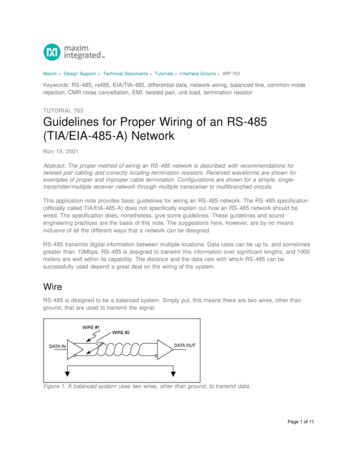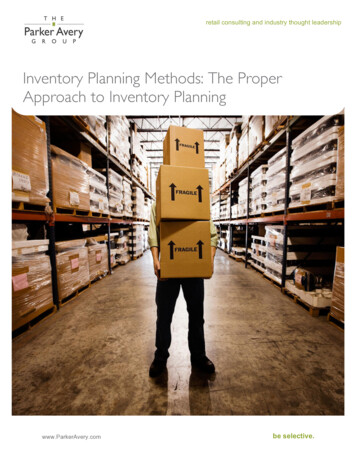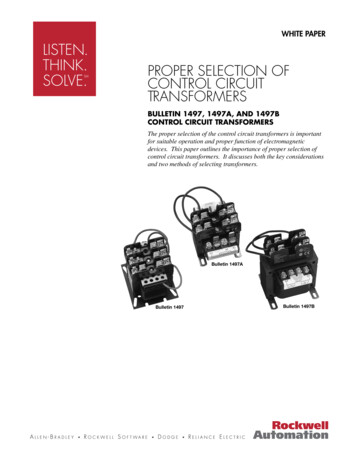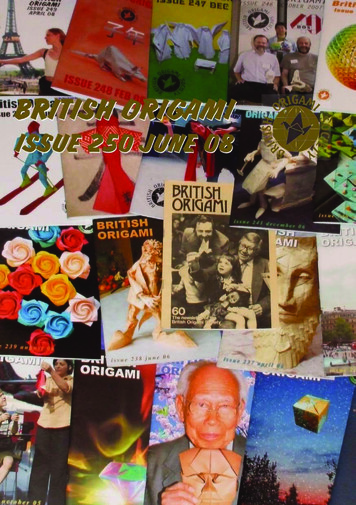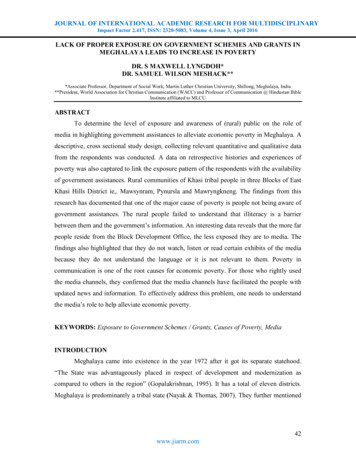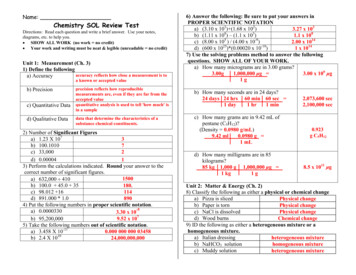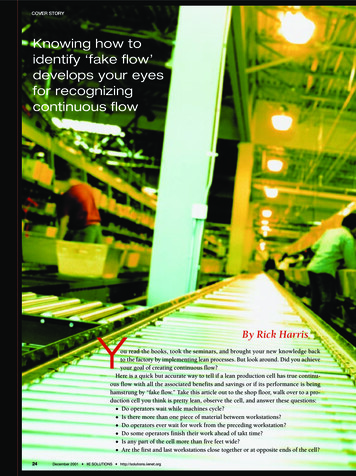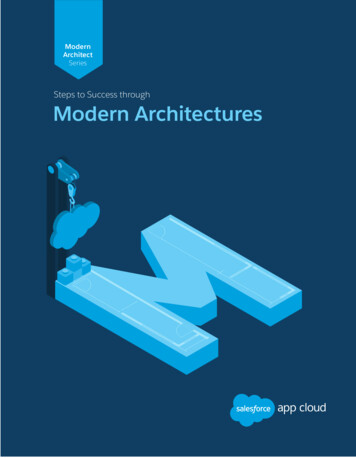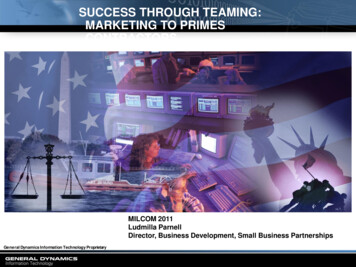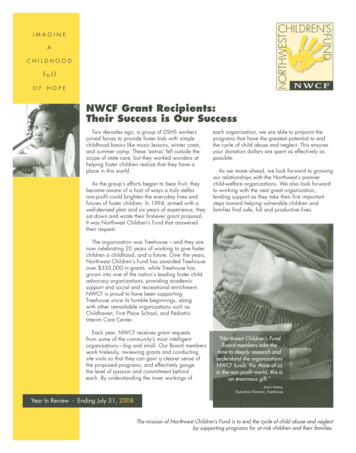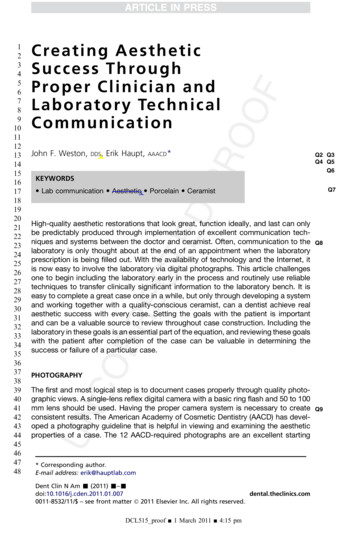
Transcription
0313233343536373839404142434445464748C re a t i n g A e s t h e t i cS u c c e s s T h ro u g hP ro p e r C l i n i c i a n an dL a b o r a t o r y Te c h n i c a lCommunicationJohn F. Weston,DDS,Erik Haupt,AAACD*Q2 Q3Q4 Q5Q6KEYWORDS Lab communication Aesthetic Porcelain CeramistHigh-quality aesthetic restorations that look great, function ideally, and last can onlybe predictably produced through implementation of excellent communication techniques and systems between the doctor and ceramist. Often, communication to thelaboratory is only thought about at the end of an appointment when the laboratoryprescription is being filled out. With the availability of technology and the Internet, itis now easy to involve the laboratory via digital photographs. This article challengesone to begin including the laboratory early in the process and routinely use reliabletechniques to transfer clinically significant information to the laboratory bench. It iseasy to complete a great case once in a while, but only through developing a systemand working together with a quality-conscious ceramist, can a dentist achieve realaesthetic success with every case. Setting the goals with the patient is importantand can be a valuable source to review throughout case construction. Including thelaboratory in these goals is an essential part of the equation, and reviewing these goalswith the patient after completion of the case can be valuable in determining thesuccess or failure of a particular case.Q7Q8PHOTOGRAPHYThe first and most logical step is to document cases properly through quality photographic views. A single-lens reflex digital camera with a basic ring flash and 50 to 100mm lens should be used. Having the proper camera system is necessary to createconsistent results. The American Academy of Cosmetic Dentistry (AACD) has developed a photography guideline that is helpful in viewing and examining the aestheticproperties of a case. The 12 AACD-required photographs are an excellent starting* Corresponding author.E-mail address: erik@hauptlab.comDent Clin N Am - (2011) s.com0011-8532/11/ – see front matter Ó 2011 Elsevier Inc. All rights reserved.DCL515 proof 1 March 2011 4:15 pmQ9
2Weston & 6979899point toward successful communication (Figs. 1–3). Properly exposed and framedphotographs allow the ceramist to see what materials and techniques are necessaryto create the final result. Additional photographs to consider beyond these would beshade reference views of lips in repose or at rest. Theseare valuable views to determine the final length of the central incisors, which is typically 2 to 3 mm should be displayed beyond the edge of the upper lip (Fig. 4). Lastly, it is important that all thephotographs are taken with the teeth well hydrated. A tooth that is dehydrated willhave a higher value and chroma than a hydrated one. These photographs set the foundation for all successful dentist/ceramist teams.Q10MODELSIt is always valuable to record the detail of shapes and positions of the natural teethbefore providing any treatment via models. Because of the availability of inexpensivePVS materials, alginate impressions are no longer the standard of care for opposing orpreoperative models. The laboratory technician will often refer back to the originalteeth many times while building a case to see what features of the patients’ teethneed to be incorporated in the new design. Providing accurate and reproduciblemodels is an important issue. Subtle details in texture, anatomy, and contours keepthe ceramic restorations from looking contrived and can provide the element of“perfect imperfection” that natural teeth exhibit. One should never underestimatethe value of what was working in a patients smile before the case was started. Themost beautiful smiles are created in the laboratory by looking for ways to improvewhat nature provided instead of erasing and rebuilding from scratch.Q11JAW RELATION RECORDSprint & web 4C FPOThere are many theories on the best way to manage restorations with regard to occlusion. There is also a great debate about which theory is right. However, there is nodebate about the fact that there should be a consistent method that provides a reliableand repeatable record to mount models and build a case. In the end, the model mustbe able to occlude with function and comfort for sustained periods and not overloadthe muscles, joints, or teeth. Having accurate bite records helps to confidently crossmount all models from preoperative to prepared to provisional, allowing the laboratorytechnician maximum ability to build an accurate occlusal scheme. Typically, once thereconstruction proceeds beyond the canines, a face bow transfer is indicated. Thisprocess requires the laboratory technician and doctor to have the same articulators.Fig. 1. An AACD-required photograph, front smile view.DCL515 proof 1 March 2011 4:15 pmQ12
print & web 4C FPOFig. 2. An AACD-required photograph, front retracted view.Fig. 3. An AACD required photograph, front close-up view.print & web 4C 149150print & web 4C FPOClinician and Laboratory Technical CommunicationFig. 4. Properly framed, lips at rest or repose, note proper incisal display.DCL515 proof 1 March 2011 4:15 pmQ1 3
Weston & HauptFig. 5. Stick bite secured to lower teeth, horizontal to the plane of the earth.The face bow can be transferred to the laboratory by sending the face bow hardwareand bite fork mount, or the clinician can simply mount the upper model. Horizontalreferences, commonly called “stick bites” (Fig. 5) are also important at this stage toprevent the formation of a canted midline. Studies show that canted midlines arethe most noticed of all midline discrepancies, and mounting the casts properly in relation to the plane of the earth and a patient’s face can help prevent canting.SHADE COMMUNICATIONProper shade reference photographs are one of the most important tools for communicating with a dental laboratory. Many dentist/ceramist teams are geographicallyseparated thus eliminating the opportunity for the patient to drive back and forthbetween offices. Having the final shade incorrect is often the number one issue leadingto an unsatisfied patient. Always, multiple views should be taken with and withoutretractors, using multiple shade tabs on hydrated teeth. These views will have theshade tab on a parallel plane with the referenced tooth (Fig. 6). It is also importantto have the same amount of light on both the shade tab and the referenced tooth.Another important photograph for the laboratory is that of the prepared tooth. Manyall-ceramic restorative materials, once seated, are influenced by the preparationshade. The laboratory technician needs to see a photograph of the dentin to appropriately build the intended shade. Using software, the laboratory technician can thenprint & web 4C 200201print & web 4C FPO4Fig. 6. A properly framed shade reference photograph.DCL515 proof 1 March 2011 4:15 pm
Clinician and Laboratory Technical 7248249250251252digitally manipulate the images to discern levels of value and chroma (Fig. 7). It is alsoimportant to make sure that the laboratory technician’s and clinician’s computer monitors are calibrated so that each person sees the same color combinations. The camerahas to be set with proper white balance, f-stop, and flash sync for properly exposedimages. As a backup, a color calibration card can be used to make sure that the shadeis properly represented in the images that are sent to the laboratory. What may seemintimidating to a dentist is simplified by working with companies that can set up thedental clinical camera, (Photomed Inc) for consistent results.5Q13DIGITAL SHADE COMMUNICATIONThere are also computerized devices that can make shade matching available to eventhe most color-challenged individuals. A person can literally point the device on thesurface of a tooth, and within seconds, a shade will be given on a liquid crystal displayscreen (Fig. 8). Although the shade may not be accurate in every case, it gives a starting point and with the assistance of photography, allows additional ability to extrapolate all the nuances within a tooth.PORCELAIN CHARACTERIZATIONAn important skill required in creating porcelain restorations that appear natural iscontrolling the amount of characterization. Natural teeth have varying amounts ofincisal translucency, and the ceramist needs to recreate this characteristic accurately.What may seem simple often involves more that just placing porcelain across theincisal edge. There are many colors and effects seen within natural teeth that correspond to different incisal porcelain powders. A helpful communication tool by usingexamples of teeth from published books allows dentists to describe how much, value,chroma, and incisal character they desire. Whether natural teeth or restorations, colorphotographs of desired characteristics can prove invaluable. Additional informationfor incisal characterization can be obtained by taking a photograph at a 30 downwardangle to the facial plane of the natural tooth (Fig. 9). This technique provides an excellent record of incisal translucency.PREPARATION DESIGN AND MATERIAL SELECTIONThe teeth should always be prepared in a way that preserves as much tooth structureas possible. Once the goals of the case are determined, preparations should beFig. 7. Black and white conversion to see value.DCL515 proof 1 March 2011 4:15 pmQ14Q15
Weston & HauptFig. 8. Easyshade device in use, results are instant (A, B).decided clinically based on design parameters, shade requirements, and availabletooth structure. Restorative material choices should be finalized in the laboratory tomatch the strength and aesthetic goals required by the case while meeting the preparation clearances provided. Blindly preparing teeth just to fit the parameters ofcertain restoratives could be considered inappropriate and, in some cases, malpractice. Porcelain veneering was initially introduced as a “no prep” procedure. Whereasbonding strengths were very high because of the large amount of enamel bondingavailable, the feldspathic materials used at the time had strength limitations. Now,because new materials such as lithium disilicate are available at minimal thickness,there is a resurgence of preparationless or minimal preparation options. This resurgence has created a positive effect on the profession as a whole and serves to reeducate the patients and profession to the important philosophy that minimal removal ofexisting tooth structure should always be a top priority.TEMPORIZATIONOne of the key concepts that dentist’s need to understand is that provisionals serve asthe foundation to building a successful case. The 2 most common methods to creatingprovisionals are using templates from a direct mock-up technique or laboratory waxup. With a direct mock-up, the restoring dentist uses a flowable composite to adddirectly to the patients existing dentition creating an ideal smile. Once this mock-upis completed, the dentist makes an impression and uses this as a guide for the finaltemporaries. Another option would be to have the laboratory create a wax-upprint & web 4C 302303print & web 4C FPO6Fig. 9. Clear incisal character displayed on natural tooth.DCL515 proof 1 March 2011 4:15 pmQ23
Clinician and Laboratory Technical Communicationidealizing the patients existing tooth form. This wax-up is then used to create a matrixfor provisional fabrication. Although the methods differ in technique, the result is thatpatients have a set of provisionals that they can wear while the final porcelain iscreated. Any functional or aesthetic issues can be worked out with plastic insteadof the final porcelain provisional, thus allowing patients to approve their provisionalsmile before insertion of the final porcelain. Careful planning and attention to provisionals are essential for predictable outcomes and satisfied patients.CASE PRESENTATIONWhen the patient first arrived to the office, it was immediately apparent that he waswearing down his anterior teeth. As a recent college graduate, he thought that havinga better smile might help him be competitive in the job market. A recent survey by theAACD revealed that a person with a pleasing smile is more likely to get hired for a job(Figs. 10 and 11). A photograph of lips in repose or at rest showed minimal, if any,tooth display, with the central incisors measuring only 9 mm (Fig. 12). The first stepwas to prepare a mock-up ideal incisal edge position for teeth 8 and 9 using flowablecomposite. By starting with the central incisors, the dentist can develop the rest of thesmile and the patient can visualize the intended result (Fig. 13). Photographs are madealong with reduction guides and impression template for final provisionals beforeremoving the mock-up. After consultation with the laboratory technician regardingthe materials, it was decided that a thin application of lithium dislicate veneer wouldsatisfy the restorative demands. Careful preparations were completed with diamondinstruments while constantly referring to reduction guides to confirm that the preparations stayed within the enamel layer while ensuring a passive fit devoid of any sharpangles.The Lava Chairside Oral Scanner C.O.S., 3M ESPE, was used to accurately capturedigital impressions of the preparations and opposing arch along the CO bite record(Fig. 14). The prescription was filled out on the screen and the case e-mailed for processing. It takes about 3 days for the mounted, articulated, pinned models to arrive inthe laboratory. The first step for the ceramist, after viewing the preparations, is toconfirm the horizontal reference. As mentioned earlier, a midline cant will most oftenbe noticed by even the most nondentally educated person, whereas a midline deviation will often go unnoticed. In general, a laboratory technician should mount the studycasts in the same relation as a photograph of the patient with the provisionals. Thisprint & web 4C 3533547Fig. 10. Smile view showing short worn incisal edges.DCL515 proof 1 March 2011 4:15 pmQ16Q17Q18
Weston & Hauptprint & web 4C FPOFig. 11. Close-up view shows severely worn incisal edges.Fig. 12. Lips in repose shows lack of proper tooth display.print & web 4C 404405print & web 4C FPO8Fig. 13. Mock-up of incisal edges shows improved smile line.DCL515 proof 1 March 2011 4:15 pm
Fig. 14. Digital impression image from the Lava Chairside Oral Scanner C.O.S.mounting should be compared with the stick bite as well. Once the case is properlymounted, fabrication of the ceramics can begin.During the process of fabricating the case, the ceramist will often compare theporcelain shapes with those of the provisionals, original teeth, as well as photographs.By fabricating a matrix of the incisal edge positions of the temporaries, one is able toconfirm that the porcelain design follows the patient-approved provisional created bythe doctor (Fig. 15). The porcelain is layered in several steps to achieve the desiredhue, value, chroma, and incisal character or halo effect. On completion of the ceramic,the technician etches the internal surface with the proper hydrofluoric acid so that theyare ready for resin bonding.On the day of insertion, the provisionals are carefully removed and the preparationscleaned and disinfected. For this patient, no anesthesia was used because the preparations were completely in enamel and the patient experienced zero sensitivity evenafter etching (Fig. 16). A dry try-in was performed to confirm the marginal and proximalfit (Fig. 17). Typical “total etch” porcelain to enamel bonding was accomplished usinga fifth generation single bottle system (Adper Single Bond Plus Adhesive and RelyXprint & web 4C 455456print & web 4C FPOClinician and Laboratory Technical CommunicationFig. 15. (A) Incisal edge guide from the provisional provides a reference for the lab. (B)Restorations showing proper contours and color distribution.DCL515 proof 1 March 2011 4:15 pm9
Weston & Hauptprint & web 4C FPOFig. 16. Etched preparations showing significant enamel bonding available.Fig. 17. Dry try-in used to verify marginal and proximal fit.print & web 4C 506507print & web 4C FPO10Fig. 18. Immediate postseating.DCL515 proof 1 March 2011 4:15 pm
print & web 4C FPOFig. 19. Improved smile line and natural aesthetics.Fig. 20. Detail of incisal edge porcelain.print & web 4C 557558print & web 4C FPOClinician and Laboratory Technical CommunicationFig. 21. Improved tooth display with lips at rest.DCL515 proof 1 March 2011 4:15 pm11
575576577578Weston & HauptTransleucent Veneer Cement, 3M ESPE). A rapid seating technique was used, and allrestorations were seated, tacked, and cement cleaned followed by final curing for40 seconds with an oxygen barrier of glycerin gel.Gentle cleaning at the margins was completed with a No. 12 BP blade; no burs wereused on the facial margins. Lingual margins were finished with a fine red stripe footballdiamond (Brassler) and polished after occlusion verification using Shofu rubber tips,medium and fine. Interproximal areas were cleaned and polished using a yellow perforated diamond strip, Brasseler, and floss passed through to verify the interproximalcleanliness (see Fig. 17).This case was finished with minor occlusal equilibration, addition of composite tolower canines, and full coverage bite guard therapy for nighttime use.The final photographs of this case reveal the kind of results that can be achievedroutinely by following proven systems and techniques. Having a clear understandingof the goals of a case and being able to communicate accurately with the ceramist arethe keys to success. By using digital cameras and digital impression technology, weare able to improve our ability to not only communicate but also enhance outcomesand improve predictability even when the laboratory is long distance. This case isan example of how proper planning and communication produce excellent clinicalresults while improving function and aesthetics (Figs. 18–21).DCL515 proof 1 March 2011 4:15 pmQ19Q20Q21 Q22
Our reference: DCL 515P-authorquery-v9AUTHOR QUERY FORMJournal: DCLArticle Number: 515Dear Author,Please check your proof carefully and mark all corrections at the appropriate place in the proof (e.g., by using on-screenanno
John F. Weston, DDS, Erik Haupt, AAACD* Q2 Q3 Q4 Q5 Q6 High-quality aesthetic restorations that look great, function ideally, and last can only be predictably produced through implementation of excellent c
